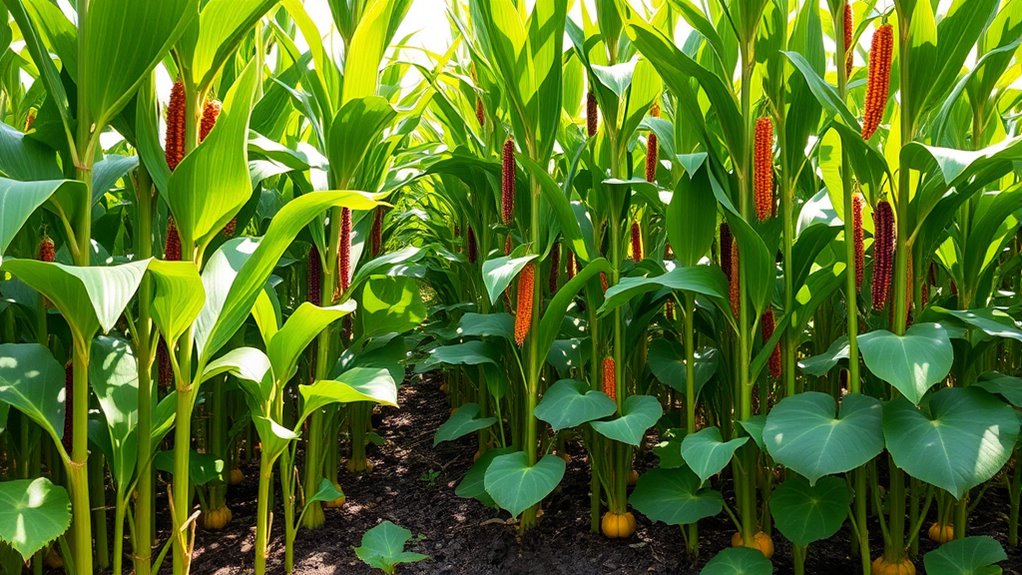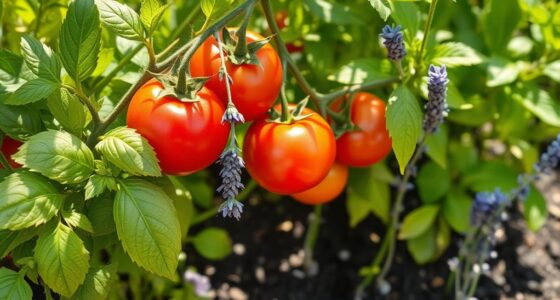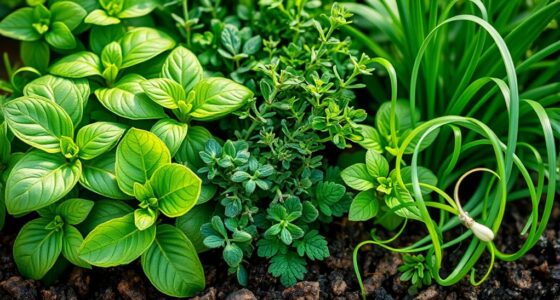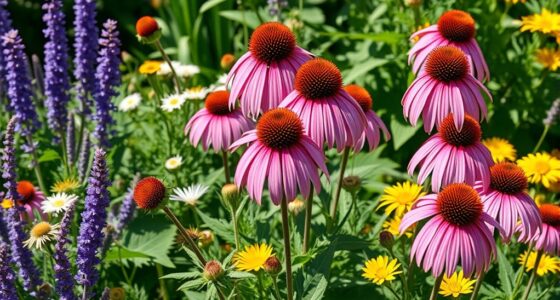For a successful Three Sisters garden, plant beans to climb cornstalks, fixing nitrogen and conserving space. Add squash or gourds as ground cover to suppress weeds and keep moisture. Support taller crops with sunflowers and attract pollinators with marigolds, zinnias, or native wildflowers. Incorporate herbs like basil or oregano for pest control, and include nasturtiums or cucumbers for added pest deterrence and soil health. Keep exploring how these companions work together for a thriving, sustainable garden.
Key Takeaways
- Beans fix nitrogen and climb corn stalks, maximizing space and soil fertility.
- Sunflowers provide natural support and attract pollinators, enhancing biodiversity.
- Squash and ground covers suppress weeds, retain moisture, and shade soil.
- Marigolds and herbs repel pests and attract beneficial insects for natural pest control.
- Diverse flowering plants boost pollination, ecosystem health, and garden resilience.
Beans: The Classic Climber for Corn
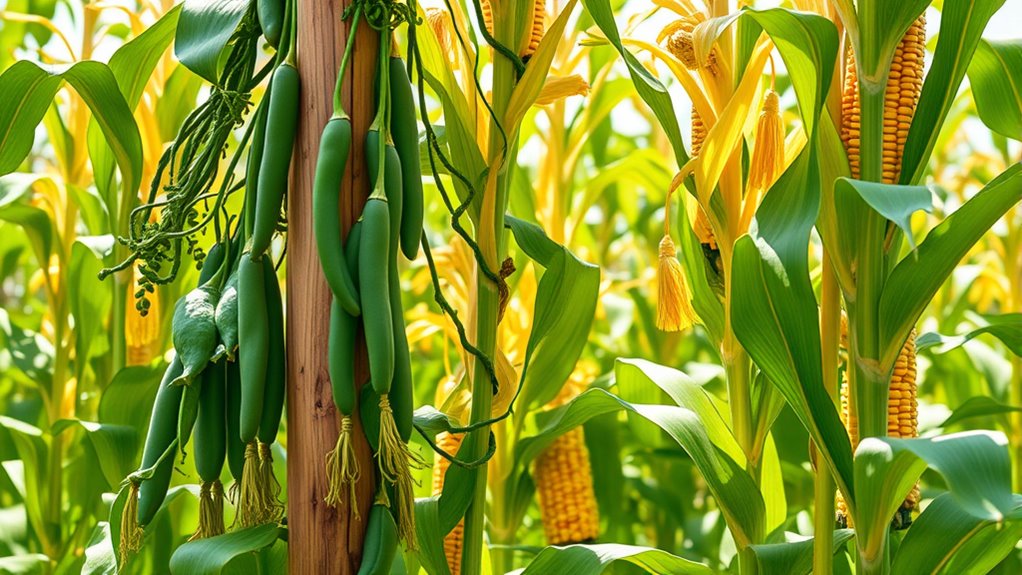
Beans are a traditional and effective companion for corn because they climb the stalks, saving space and providing natural support. As you plant beans alongside your corn, you’ll notice how they use the tall stalks to reach upward, reducing the need for trellises. This mutual benefit helps maximize your garden’s space, especially in small plots. Beans fix nitrogen in the soil, nourishing both themselves and the corn, leading to healthier, more vigorous plants. Nitrogen fixation is a key process that enhances soil fertility naturally. As the beans grow, they shade the soil slightly, retaining moisture and suppressing weeds. You’ll appreciate how this partnership creates a thriving, low-maintenance system. Plus, harvesting beans alongside corn lets you enjoy two crops from the same area, making your garden more productive and sustainable. Active listening and understanding the needs of each plant can further enhance the success of this companion planting method. Incorporating soil health practices can further boost the benefits of this traditional planting method.
Squash and Other Ground Cover Plants

Planting squash and other ground cover plants around your corn can considerably improve your garden’s health and productivity. These plants act as natural mulch, suppressing weeds and conserving soil moisture. Squash, with its broad leaves, shades the soil, reducing temperature fluctuations and preventing weed growth. Additionally, squash attracts beneficial insects that help control pests, offering natural pest management. Their sprawling growth minimizes soil erosion and keeps weeds from taking over. Some ground covers like pumpkin or gourds can also be interplanted to maximize space. Be sure to leave enough room for the squash to spread without crowding your corn stalks. Incorporating soil moisture retention strategies further enhances plant health and yields. This combination creates a balanced ecosystem that supports healthy plant growth and increases your harvest.
Sunflowers as Natural Supporters

Have you considered how sunflowers can naturally support your corn plants? Sunflowers grow tall and sturdy, making them excellent natural trellises for climbing plants like beans or even corn stalks that need added stability. Their robust stems provide a strong framework, helping to support the weight of taller crops and reducing the risk of lodging during storms. Additionally, sunflowers attract beneficial insects such as pollinators and predatory insects, which can help control pests around your corn. Their large leaves create some shade, which can protect your corn from excessive heat and sun stress. Intercropping methods are also being explored to optimize crop management and improve yields in sustainable farming practices. By planting sunflowers nearby, you enhance both the structural support and ecological balance of your garden, creating a healthier environment for your corn to thrive. Furthermore, incorporating companion plants like sunflowers can promote biodiversity and resilience in your garden ecosystem. Recognizing the importance of plant relationships can lead to more effective and sustainable gardening strategies. Additionally, understanding the beneficial effects of plant companions can further optimize your crop productivity and health.
Marigolds for Pest Control and Pollinator Attraction
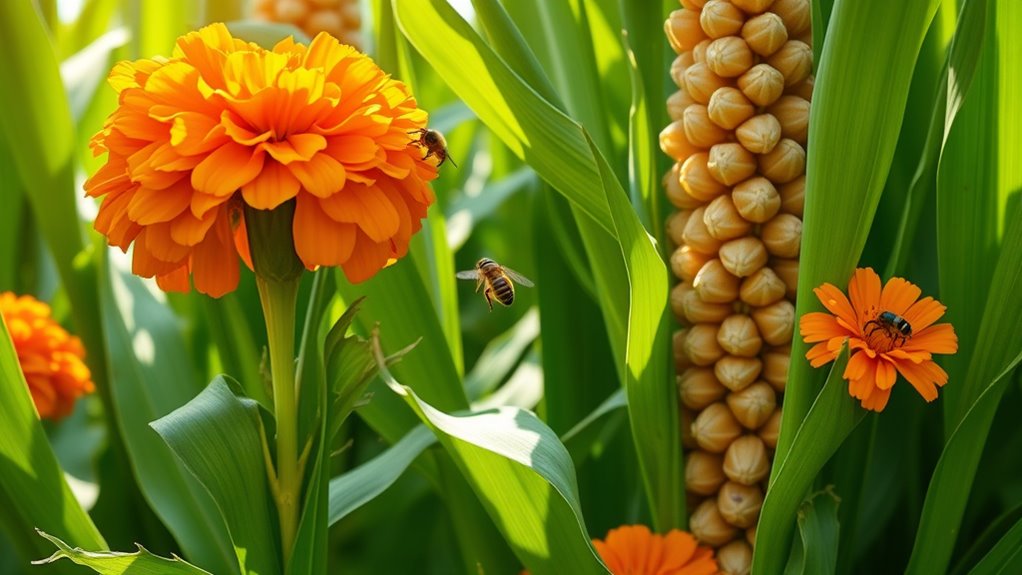
Marigolds are a vibrant addition to your corn garden, offering both pest control and pollinator attraction. Their strong scent deters pests like nematodes, beetles, and aphids that target corn. Planting marigolds around your corn acts as a natural barrier, reducing the need for chemical pesticides. Additionally, marigolds attract pollinators such as bees and butterflies, which help improve pollination and increase your harvest. Their bright orange and yellow flowers draw beneficial insects that keep other pests in check. Besides attracting pollinators, marigolds can also contribute to integrated pest management by naturally reducing pest populations. Furthermore, their presence can enhance attention in your gardening routine by encouraging mindful observation of plant health. Plus, marigolds are easy to grow and thrive in full sun, making them an ideal companion. Incorporating natural pest control into your garden helps create a healthier, more resilient environment. Using companion plants like marigolds also supports sustainable gardening practices, promoting a balanced ecosystem. By doing so, you create a healthier, more resilient garden that benefits from natural pest control and enhanced pollination.
Nasturtiums to Deter Pests and Attract Beneficial Insects
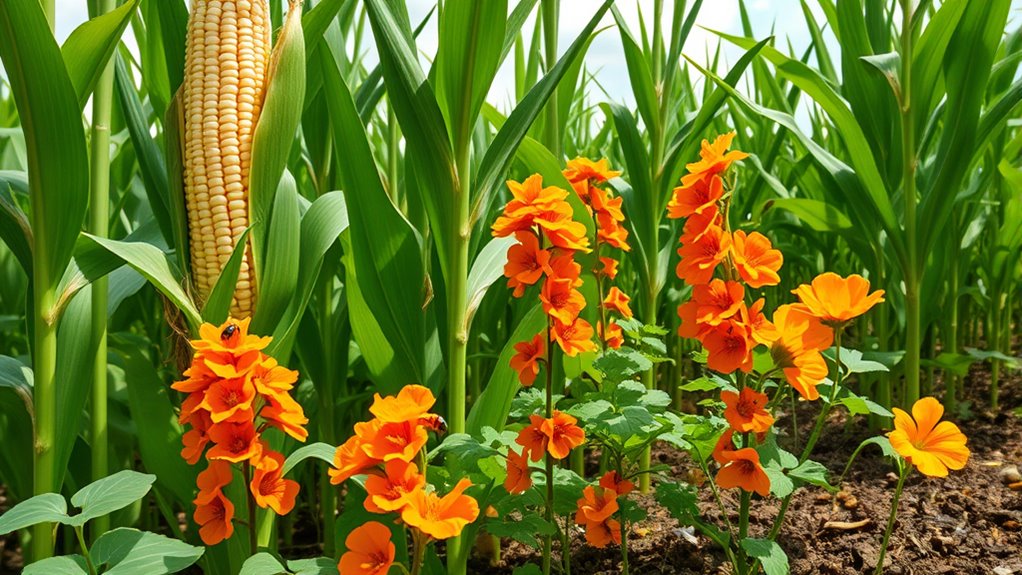
Nasturtiums are a dynamic addition to your corn garden, serving both as natural pest deterrents and beneficial insect attractors. Their bright, colorful flowers draw in pollinators like bees, helping boost overall plant health. At the same time, nasturtiums act as trap crops, attracting aphids, flea beetles, and squash bugs away from your corn. This helps reduce pest populations naturally, minimizing the need for chemical controls. Their scent also confuses pests, making it harder for them to locate your corn plants. By planting nasturtiums nearby, you create a protective barrier that encourages beneficial insects such as ladybugs and predatory wasps to settle in, further controlling pests. Overall, nasturtiums enhance your garden’s ecological balance while contributing to healthier, pest-free corn.
Cucumbers as Companion Plants

Did you know cucumbers make excellent companions for corn? When planted together, cucumbers thrive alongside corn, creating a beneficial partnership. They help cover the soil, reducing weeds and conserving moisture, which keeps your garden healthy and productive. Cucumbers also attract pollinators, boosting pollination for both plants. Their sprawling vines can shade the soil, preventing it from drying out too quickly. This mutual support encourages a thriving, vibrant garden where both plants flourish. Plus, cucumbers are easy to grow and harvest, making your gardening experience more rewarding. Filtration systems in garden soil can help improve plant health and reduce pests. Together, cucumbers and corn form a dynamic duo that boosts your harvest and enhances garden health. By planting cucumbers near your corn, you’re creating a lively, productive garden filled with growth and abundance.
- Feel the satisfaction of a thriving, lush garden.
- Watch your plants grow stronger and healthier.
- Enjoy a bountiful harvest with less effort.
Herbs That Enhance Growth and Repel Pests
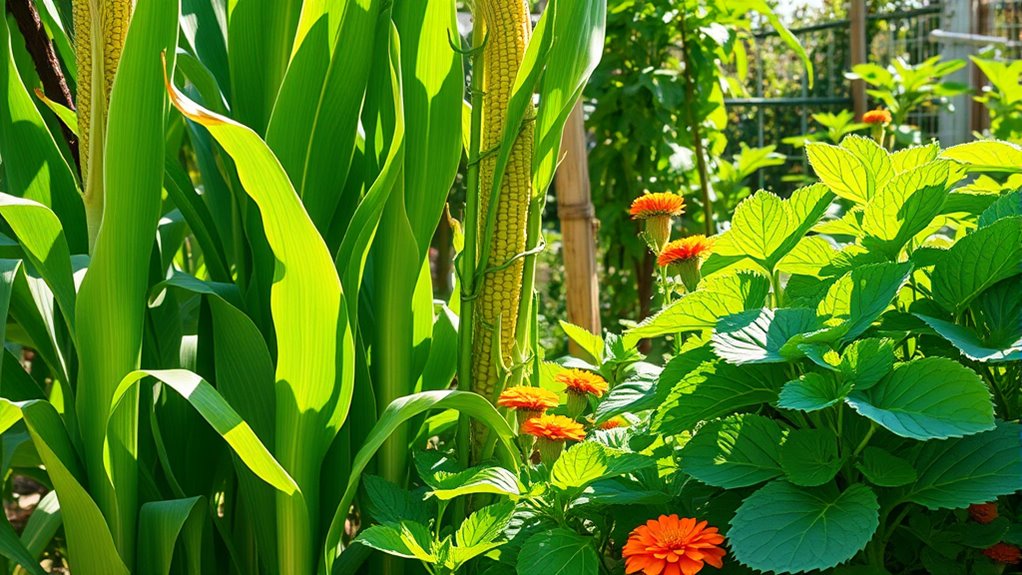
Herbs can play a pivotal role in promoting healthier growth and protecting your corn from pests. Planting herbs like basil, oregano, and mint nearby can help deter insects that threaten your crop. Basil repels flies and aphids, while oregano and marigolds can fend off nematodes and beetles. Mint, when contained, acts as a natural repellent for ants and flea beetles. These herbs also attract beneficial insects, such as predatory wasps and ladybugs, which help keep pest populations in check. Additionally, their aromatic oils can improve soil health and stimulate plant growth. Incorporating these herbs into your corn garden creates a natural pest barrier and promotes a healthier, more vigorous crop without relying on chemical pesticides.
Pollinator-Friendly Flowers to Boost Yield

Incorporating pollinator-friendly flowers into your corn garden can considerably enhance pollination and increase yields. When bees and butterflies visit these vibrant blooms, they transfer pollen more effectively, resulting in healthier, more abundant corn. Plus, these flowers add beauty and diversity to your garden, creating a lively ecosystem. To attract and support pollinators, consider planting:
- Bright, nectar-rich blooms like sunflowers and zinnias to draw in bees and butterflies.
- Native wildflowers that provide essential nectar throughout the season.
- Climbing flowers such as sweet peas that offer shelter and additional forage for pollinators.
- Supporting pollinators can also boost the overall pop culture influence of your garden ecosystem, making it more vibrant and sustainable. Additionally, planting a variety of these flowers can help manage costs associated with garden maintenance by encouraging natural pollination and pest control. Promoting healthy ecosystems through diverse plantings not only benefits pollinators but also enhances soil health and plant resilience. Implementing these diverse floral strategies can further improve the efficiency of heat pumps in maintaining optimal garden conditions, fostering a healthier environment for your crops.
Frequently Asked Questions
Can Companion Planting Increase Corn Yield Significantly?
Companion planting can definitely boost your corn yield by improving soil health, repelling pests, and supporting growth. When you plant compatible companions alongside corn, they work together naturally, enhancing each other’s growth. For example, planting beans fixes nitrogen in the soil, benefiting corn, while marigolds can deter pests. So, by choosing the right plants, you can increase your harvest and create a healthier, more resilient garden.
Are There Any Plants to Avoid Near Corn?
You should avoid planting certain species near corn, as they can hinder its growth or cause pests. For example, avoid planting pole beans or lima beans close to corn because they can compete for nutrients or attract pests. Also, steer clear of garlic or onions nearby, since their strong smell may repel pollinators or interfere with corn’s growth. Being mindful of these plant choices helps guarantee your corn thrives.
How Do I Select the Best Companion Plants for My Climate?
To select the best companion plants for your climate, start by understanding your local growing zone and seasonal conditions. Choose plants that thrive in your temperature, rainfall, and soil type. Research what grows well in your area and consider how plants can benefit each other, like providing shade or fixing nitrogen. Adapt your choices based on your specific environment to make certain of healthy growth and a successful garden.
What Are the Benefits of Planting Herbs With Corn?
Imagine a gentle breeze carrying fragrant whispers around your garden. Planting herbs with corn offers benefits like natural pest repellents, which keep unwanted visitors at bay, and improved soil health, as herbs enrich the earth with their roots. Plus, their aromatic leaves can attract beneficial insects that help pollinate your corn. This symphony of plants creates a thriving, balanced environment, leading to healthier, more productive harvests.
How Does Soil Health Impact Companion Planting Success?
Soil health plays a vital role in your companion planting success. When your soil is rich in organic matter, nutrients, and proper pH, it supports healthy root growth and boosts plant resilience. Healthy soil encourages beneficial microbes that fight pests and improve nutrient uptake. By maintaining soil vitality through composting and crop rotation, you create an environment where your plants thrive, increasing the overall productivity of your garden.
Conclusion
By choosing the right companions, you turn your garden into a thriving symphony of growth and protection. Like a well-orchestrated dance, these plants support, shield, and enhance each other’s essentiality. When you plant beans, squash, sunflowers, and herbs together, you’re weaving a vibrant tapestry of life that boosts your corn’s bounty. Embrace this harmonious trio, and watch your garden flourish like a well-tuned orchestra playing nature’s sweetest melody.
